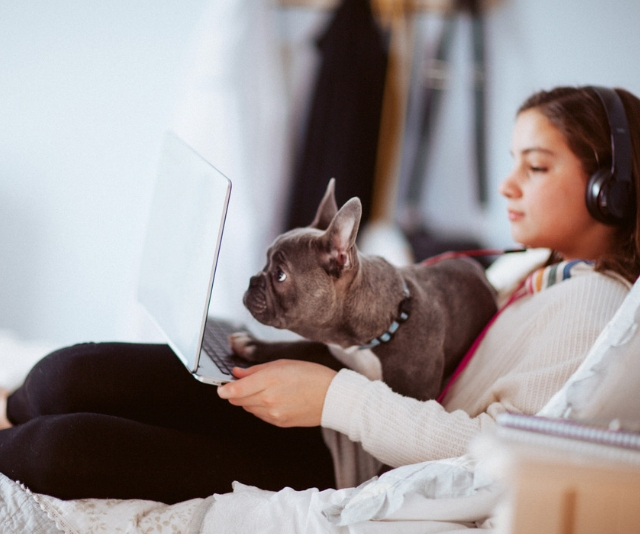Child Protection Week: How to make sure your child stays safe online
"If there is only one thing you do, let your child know they can tell you anything and you will not judge them."
By Natalie Siegel-Brown, Managing Director of Child Wise
It’s easy to forget that these powerful machines in our pockets also give young people a voice in a society where the dominant power structures say kids’ voices are less important than adults’. At the same time, there are real dangers that we need to safeguard against so it’s my goal to maximise the ability of kids to engage with technology while minimising the risks.
Regularly interacting with peers is an essential part of becoming a healthy adult and socialising has proven beneficial for many learning outcomes. The digital world allows children to seek support from their peers they might not have asked for face to face and lifelong friendships can blossom extending well beyond DMs or gaming.
Especially as adolescents and teen brains grow, socialising with peers and people outside of the immediate family circle is critical to growing their brain architecture and understanding of human belief systems, intentions and to grow self-esteem. So in a world where they are locked down and locked away from their peers, technology might be the only way they have to communicate with their friends and feed this hungry part of the brain. Dutch psychologists recently showed how important this is to the mental health of our teens.

Natalie Siegel-Brown is the Managing Director of Child Wise and the former Queensland Public Guardian.
Not only that, but suddenly kids have an equal platform to express their views and be heard in a society that often thinks they can’t have a view. And some of the new apps mean kids are able to disclose their deepest fears, anxieties and darkest experiences to services that will never respond with “you’ve come through the wrong door, try calling here instead”.
So while there is lots of good stuff, there is also a very dangerous side. But this doesn’t mean we should throw the baby out with the bathwater. There is so much you can do as a parent to facilitate the mental health benefits of technology (especially during lockdown) – not to mention the safety net it can give kids to disclose abuse – while making sure our kids stay safe.
Young people using the internet to connect are more susceptible to a range of threats from identity theft and cyberbullying through to being lured into sharing nude photographs, sexual exploitation or blackmail.
So what can you do? Well, you might already know some of the most basic tools: like monitoring screen time and using parental control and website blocker software. But there is a lot more. Parents and teachers don’t need to be more digitally savvy to effectively protect children online, they need to communicate the benefits and risks before there is a problem. So here are some key things you should know….

Don’t feel bad if they don’t tell you what’s going on.
If there is only one thing you do, let your child know they can tell you anything and you will not judge them.
You will believe them and you will help them. The biggest barrier to disclosure is fear of shame and judgment. They need to know you will support them and that you won’t blame them. Don’t force them to disclose, let them know they have all the time they need. You want to create an environment which encourages disclosure – or even the comfort zone to say to you “hey, this just happened, does this sound right to you?” or “this person is creepy”. That gives them a licence to intervene or stop something before it goes seriously wrong.We need to build their confidence in disclosing without fear or shame and to know what to do when this happens. Just showing interest in their lives and interest in their interest will go a long way.
Threatening to take away devices or actually taking them away if they have done something bad online and told you about it, will only make kids go to ground.
This will give you the opposite impact to the above. Many kids may not disclose for fear of having the technology taken away from them. Remember, our kids live in a world where there is a seamless existence between the physical and digital spheres. Abstinence doesn’t fix anything. It may just deter disclosure. You want to create an environment where kids feel open to disclose without fear of your judgment or of being forced only into the offline world where they feel isolated.

If there is only one thing you do, let your child know they can tell you anything and you will not judge them.
Don’t feel bad if they don’t tell you what’s going on.
Depending on the age of the child, they just may not feel comfortable sharing this stuff with you as an adult. In fact we hear a lot from older kids that they are getting disclosures from younger kids who are scared to tell parents or carers. The older kids are perplexed because they haven’t got the tools to offer support either. As a society, we try to equip adults to respond to, and support children who have suffered harm. But we actually need to build this capacity in our young people. They carry a lot of the burden and stories from their friends.
Teaching them how to handle disclosures of harm will transform them into amazing, supportive adults who will have high levels of self-efficacy, something invaluable to their adult lives.
Teach your kids that ‘private’ doesn’t mean private and ‘snap’ doesn’t mean it disappears.
A lot of kids put stuff on social media, opening their deepest, most confidential world to people in what they think is a one-to-one chat. But sadly they are posting very private material in what is actually a public forum. Even if you know the person you are speaking to, screens and photos are reshared all the time. Neither children nor adults should post personal details such as their name, address, phone number or send pictures to people they don’t know. Be prepared to explain the difference between being safe online versus social media, text messages and public forums. Some of this can be countered with parental control software and the latter can be more fundamental – like encouraging your children to use strong passwords, avoid clicking suspicious links by Googling them first to see if it’s a scam. Remind them that private accounts or messages can still be shared through screenshots.

Threatening to take away devices or actually taking them away if they have done something bad online and told you about it, will only make kids go to ground.
Get to know the apps they are using and their privacy settings.
Download the app for yourself and have a play around with it before they download it themselves, so you can determine what needs to be switched on so that default settings are minimised and the privacy settings are maximised. Help your child make sure that they cannot receive public solicitation. It is important to explain to them why you are doing this on their device – even if it’s uncomfortable to have the conversation about the dark side of the world. Not an easy ask, I know. Right now, the terms and conditions that kids have to sign up to in using social media are overwhelming – even for some adults. Many people tend to just tick “I agree” without really knowing what information they are sharing. Take the time to really read these. A study by Reset Australia lays the truth of this issue to bare. Also check out whether the app really has the ability for users to delete what they post (even if they can’t delete what they send).
Online Gaming: it’s not what you think. In fact the online gaming world is one of the worst places for predators. Many of them are able to go un-checked here. Although not widely reported in the media, a high number of children and young people have been subject to blackmail over their headphones or in the ‘chat’ functions to share nudes. Make sure you always know who your child is gaming with, and that it is a person they know in the physical world.

Teach your kids that ‘private’ doesn’t mean private and ‘snap’ doesn’t mean it disappears.
Lastly, all the things we need to teach kids about their rights in the physical world, will hold them in good stead in the physical world.
Teaching kids about healthy versus unhealthy relationships will mean they will be more alert to warning signs in both their friendships and romantic relationships online. Creating healthy relationships at home is vital to this. Here’s a really cool resource for teens to check out.
If you have very young kids, even before they enter the world of social media, teach them that private parts are for nobody else but them. Tell them that if someone tries to touch them, or does in fact do so, you will always believe them and help them. The same applies if anyone tries to touch them, or tries to force them to touch someone else.
Some people call these protective behaviours. But to be a bit controversial,I don’t like that term. We don’t want to make kids feel inadvertently responsible for ‘not protecting themselves’. But let’s flip all these conversations – and make it about their own rights. Using that language will empower them – and build your relationship of trust with them even more.




